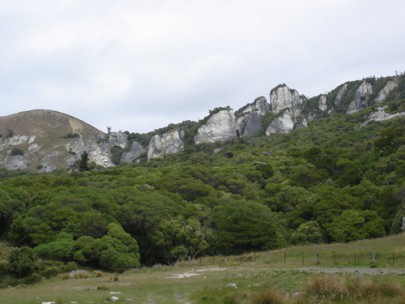Calcareous coastal cliffs
In this section
-
Coastal
- Active sand dunes
- Basic coastal cliffs
- Calcareous coastal cliffs
- Coastal cliffs on acidic rocks
- Coastal cliffs on quartzose rocks
- Coastal rock stacks
- Coastal turfs
- Dune deflation hollows
- Shell barrier beaches ('Chenier plains')
- Shingle beaches
- Stable sand dunes
- Stony beach ridges
- Ultrabasic sea cliffs

Coastal cliffs of calcareous rock at Napenape, North Canterbury (Rowan Buxton)
Coastal cliffs are very steep rock faces near the sea that are greater than 5 m in height. They may ascend in steps and have ledges, crevices and overhangs. Coastal cliffs may rise directly from the sea or be separated from it by a narrow shore. Calcareous rocks in New Zealand are primarily limestone and marble. Cliffs provide many varied habitats: from bare rock that can be colonised only by mosses and lichens to deeper soils supporting woody vegetation; from highly exposed situations to heavily shaded and sheltered habitats; and from very dry to permanently wet surfaces. Coastal cliffs are influenced by salt spray, particularly near their bases, with halophytes and succulents (e.g. Disphyma australe subsp. australe), silver tussock (Poa cita) and herbs (e.g. Einadia triandra) characteristic of these habitats. Woody plants are frequently stunted and wind-shorn and commonly include divaricating shrubs such as Coprosma species. Native species that have been lost from neighbouring habitats may find refuge on coastal cliffs.
Synonyms
Coastal cliffs of limestone rocks, coastal cliffs of marble rocks.
Notable flora and fauna
Rare and threatened plants include the nationally critical Brachyscome lucens, kaka beak (Clianthus puniceus) and Pachycladon exile, the nationally endangered coastal tree broom (Carmichaelia muritai), native hawkweed (Picris burbidgei) and Melicytus aff. crassifolius (CHR 279358; 'cliff'), the relict mawhai (Sicyos aff. australis (a) (AK 252822; New Zealand) and shore puha (Sonchus kirkii); the naturally uncommon Castlepoint daisy (Brachyglottis compacta), Beddie’s tussock (Chionochloa beddiei), Elymus sacandros,Hebe stenophylla var. hesperia, Craspedia (k) (CHR 283173; coast) and Craspedia (r) (CHR 313349; Punakaiki).
Threat status
Endangered (Holdaway et al. 2012)
Threats
Only a few weed species are present, e.g. stock (Matthiola incana), but others are approaching from urban centres (e.g. Senecio glastifolius). Farming practices do not threaten these systems, which are mostly too steep for sheep grazing, but goats can be a problem. Coastal cliff tops are desirable locations for dwellings near urban centres. As limestone is a softer rock, erosion, although it is a natural process, may be more of a problem than on coastal cliff types of harder rock types, such as granite. Most limestone mining is inland, so is not a threat to coastal calcareous cliffs. Increased erosion and inundation may result from climate change.
Where do they occur?
North Island coastal calcareous cliffs occur on Miocene sediments in eastern Wairarapa at Castle Point and at Cape Turnagain and parts of western Waikato from Port Waikato to Marokopa. South Island coastal calcareous cliffs occur in north Westland at Punakaiki, near the Heaphy River mouth, and in the vicinity of Whanganui Inlet; in south Marlborough near Flaxbourne Stream and elsewhere on the Kaikoura coast; and in North Canterbury at Motunau Beach and Napenape.
Further reading
Hawke DJ 2004. Maximum possible age of a petrel breeding colony near Punakaiki (South Island, New Zealand) from radiocarbon and stable isotope analysis of soil. Journal of the Royal Society of New Zealand 34: 1-7.
Heenan PB, Molloy BPJ 2019. Five new and Nationally Threatened taxa of Brachyscome, Cardamine, Convolvulus, Geranium and Ranunculus obligate to vulnerable limestone habitats, eastern South Island, New Zealand. Phytotaxa 415: 32–48.
Kennedy DM, Dickson ME 2007. Cliffed coasts of New Zealand: perspectives and future directions. Journal of the Royal Society of New Zealand 37: 41-57.
Park GN 1967. The vegetation and flora of Castlepoint and Cape Turnagain. Bulletin, Wellington Botanical Society 34: 6-18.
Rogers GM, Courtney SP, Heenan, PB 2018. The calcicolous vascular flora of New Zealand: life forms, taxonomy, biogeography and conservation status. Science for Conservation 331. Wellington, Department of Conservation.


